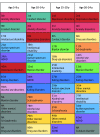Worldwide Prevalence and Disability From Mental Disorders Across Childhood and Adolescence: Evidence From the Global Burden of Disease Study
- PMID: 38294785
- PMCID: PMC10831630
- DOI: 10.1001/jamapsychiatry.2023.5051
Worldwide Prevalence and Disability From Mental Disorders Across Childhood and Adolescence: Evidence From the Global Burden of Disease Study
Abstract
Importance: The period from childhood to early adulthood involves increased susceptibility to the onset of mental disorders, with implications for policy making that may be better appreciated by disaggregated analyses of narrow age groups.
Objective: To estimate the global prevalence and years lived with disability (YLDs) associated with mental disorders and substance use disorders (SUDs) across 4 age groups using data from the 2019 Global Burden of Disease (GBD) study.
Design, setting, and participants: Data from the 2019 GBD study were used for analysis of mental disorders and SUDs. Results were stratified by age group (age 5 to 9, 10 to 14, 15 to 19, and 20 to 24 years) and sex. Data for the 2019 GBD study were collected up to 2018, and data were analyzed for this article from April 2022 to September 2023.
Exposure: Age 5 to 9 years, 10 to 14 years, 15 to 19 years, and 20 to 24 years.
Main outcomes and measures: Prevalence rates with 95% uncertainty intervals (95% UIs) and number of YLDs.
Results: Globally in 2019, 293 million of 2516 million individuals aged 5 to 24 years had at least 1 mental disorder, and 31 million had an SUD. The mean prevalence was 11.63% for mental disorders and 1.22% for SUDs. For the narrower age groups, the prevalence of mental disorders was 6.80% (95% UI, 5.58-8.03) for those aged 5 to 9 years, 12.40% (95% UI, 10.62-14.59) for those aged 10 to 14 years, 13.96% (95% UI, 12.36-15.78) for those aged 15 to 19 years, and 13.63% (95% UI, 11.90-15.53) for those aged 20 to 24 years. The prevalence of each individual disorder also varied by age groups; sex-specific patterns varied to some extent by age. Mental disorders accounted for 31.14 million of 153.59 million YLDs (20.27% of YLDs from all causes). SUDs accounted for 4.30 million YLDs (2.80% of YLDs from all causes). Over the entire life course, 24.85% of all YLDs attributable to mental disorders were recorded before age 25 years.
Conclusions and relevance: An analytical framework that relies on stratified age groups should be adopted for examination of mental disorders and SUDs from childhood to early adulthood. Given the implications of the early onset and lifetime burden of mental disorders and SUDs, age-disaggregated data are essential for the understanding of vulnerability and effective prevention and intervention initiatives.
Conflict of interest statement
Figures




Comment on
-
Age-Not Just a Number in Youth Mental Health.JAMA Psychiatry. 2024 Apr 1;81(4):327-328. doi: 10.1001/jamapsychiatry.2023.4993. JAMA Psychiatry. 2024. PMID: 38294788 No abstract available.
References
-
- United Nations . The Power of 1.8 Billion: Adolescents, Youth and the Transformation of the Future. United Nations Publications; 2014.
Publication types
MeSH terms
Grants and funding
LinkOut - more resources
Full Text Sources
Medical
Miscellaneous

